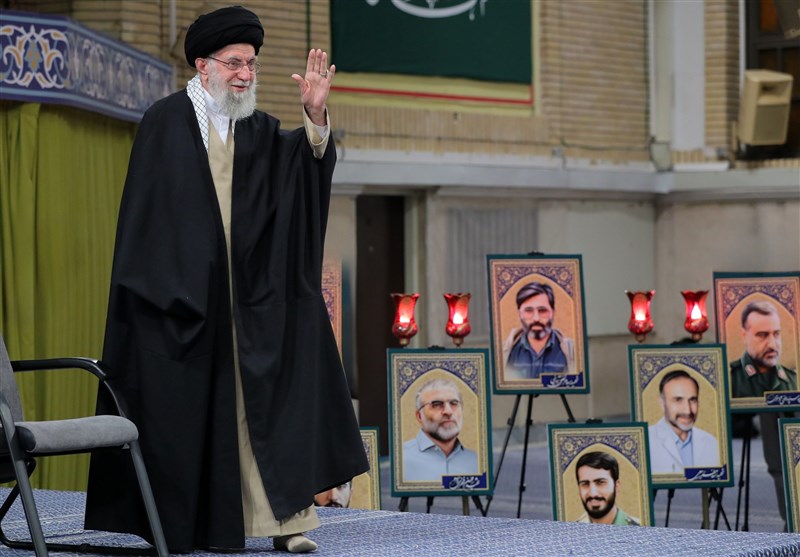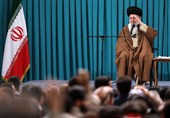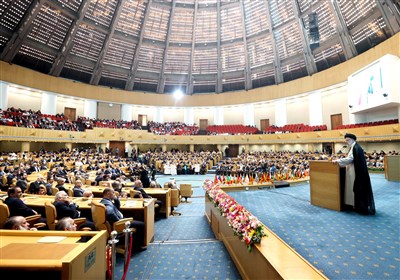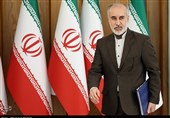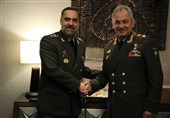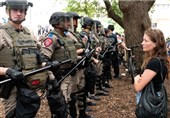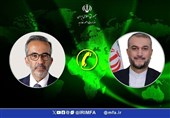God to Show Victory for Gaza: Ayatollah Khamenei
TEHRAN (Tasnim) – Leader of the Islamic Revolution Ayatollah Seyed Ali Khamenei said Almighty God will show victory and bring joy to the hearts of people in Gaza in the not-too-distant future.
He made the statement during a speech delivered in a meeting with the organizers of the National Congress for the Commemoration of Tehran’s 24,000 Martyrs, held in Tehran on January 23.
The following is the full text of the speech:
In the Name of God, the Compassionate, the Merciful
All praise is due to God, Lord of the Worlds, and peace and greetings be upon our Master and our Prophet, Muhammad, and his untainted, pure, chosen Progeny, particularly the Remnant of God on earth.
I would like to welcome all my dear brothers and sisters. Congratulations on the birth anniversary of the Master of the Pious (Imam Ali (PBUH)) and the birth anniversary of Imam Jawad (PBUH). I would like to pay tribute and respect to the pure souls of martyrs and their honorable families. I would also like to extend my thanks to all those involved in this commemoration and tribute. I saw the exhibition that has been organized by our friends here. The work that has been done is commendable. The points mentioned by our dear brother regarding Tehran, its martyrs, and the families of Tehran's martyrs are completely correct and well-founded. I would also like to share a few words with you about Tehran and the martyrs.
Not much has been said about Tehran. I, and sometimes others, have talked about different cities in the country on different occasions. Unfortunately, little has been said about Tehran despite the fact that Tehran is a representation of many aspects of the Iranian nation. That is how it truly is. Among the Iranian nation’s characteristics that became apparent in the events relating to the Revolution are the Iranian nation’s courage, zeal, its religiosity, its seeking independence, its fight against the enemy, etc. In my opinion, Tehran epitomizes all of these qualities. Therefore, if we wish to examine these traits within a specific community and based on documentation, we need to study Tehran because all of these attributes may be seen within this city.
Now, the events related to the Revolution are a complete chapter (itself). I will mention a few words about it. But before the issues and the events of the Revolution in the last 150 years at least — it was the same prior to this era, but I am going to talk mainly about the cases relating to the last century and a half — when we examine these events, we clearly see the eminence of the people of Tehran.
For example, there was the Reuter Concession, a treacherous contract that was stopped by the late Haj Mulla Ali Kani Tehrani, the people’s guide. Or there was the tobacco concession and the treasonous Régie contract when the great, supreme cleric of Tehran, the late Mirza Mohammad Hasan Ashtiani, started an uproar in Tehran following Mirza Shirazi’s fatwa calling for a boycott. They did something that caused even the workers and servants working for the Shah's family to break the hookahs, due to the (Mirza Shirazi's) fatwa. So, that was how the people of Tehran supported their scholars.
Or after that, there was the matter of Constitutional Movement. The role of the people of Tehran is often not mentioned when people speak about the case of Constitutional Movement. (Only) the story about giving rice in the (British) embassy and things like that are mentioned, which were less important events. The main issue was the people’s demand for a “House of Justice.” Tehran's people gathered in a grand mosque and other places. They held meetings and were pursuing a “House of Justice.” They put in much effort, they went through much trouble, and they were beaten, but their endeavors ultimately resulted in Constitutional Movement.
Later, when Constitutional Movement was on the brink of becoming deviated — and it did become deviated — the uprising led by the late Sheikh Fazlullah and the people, along with their sit-in protest at Abd al-Azim al-Hasani’s shrine and so forth all stemmed from the efforts of the people of Tehran. There were also the shameful Vosugh al-Dowleh (Anglo-Persian) Agreement, the nationalization of the Iranian oil industry in 1951, the 15th of Khordad (uprising), and the subsequent events from that time up until today. In every important event and significant battle that you see in Iran’s history over the past 150 years, the people of Tehran have consistently been emblematic in these events.
At times, Tehran was the only place that became involved. At other times other areas also became involved, (but the people of) Tehran were the pioneers. This is of great significance. That is how the identity of a city should be defined. The record of a city should be understood and examined through this lens.
Most of these cases that I mentioned are related to the period before the Islamic Revolution. During the Islamic Revolution, of course, different cities, such as Qom, Tabriz, Isfahan, and Mashhad played important roles. However, during all of these events, Tehran was among the pioneers. And then at that pivotal point, that is, in 1979 when the movement turned into the Revolution, Tehran was everything at that point. And its people were an inspiration for the entire country.
Consider the Eid (al-Fitr) prayer in Qeytarieh in 1979, which was held due to the forethought of the late Martyr Beheshti and others like him. This prayer, which was led by Martyr Mofatteh, had a profound impact nationwide. We were in Mashhad, but news of the events taking place in Tehran were spread to other parts (of the country). And every event that was reflected in other areas would create fervor in those various other areas. That was how Tehran was a pioneer.
(Consider) the Eid al-Fitr prayer in Qeytarieh, the epic on the 17th of Shahrivar in Shohada Square, and the Tasua and Ashura marches. These walks were held in other places too, but they were directed from Tehran. They would contact us in Mashhad from Tehran informing us of upcoming marches during Tasua or Ashura. And then we would organize them there in Mashhad too. (Thus), Tehran played a pioneering role in these events.
In all of these cases, during the same 150 years that I mentioned and also in the events of 1979, religious scholars would take the lead in the front of the crowd. Figures like Haj Mulla Ali Kani, whom I mentioned, the late Mirza Mohammad Hasan Ashtiani, Sheikh Fazlullah Nouri, Martyr Beheshti, Martyr Bahonar, Martyr Mofatteh, and Martyr Motahari were among those who led the way, and people from various backgrounds followed behind them. Even Tehran University served as a place for the ulama’s (Islamic scholars) sit-in protests. We went and sat down and discussed where to hold sit-ins. Several different places were suggested. Someone suggested Tehran University and everyone agreed. We got up and went to Tehran University for a few days until the arrival of Imam Khomeini (RA). In other words, the university helped in this movement, and once again the central and pioneering role was played by the ulama.
The important point here is that these things were done in Tehran, but where is Tehran? What is Tehran? Tehran is the city where the greatest efforts were made to alter the country’s national and Islamic identity. During the period of the Pahlavi (regime) — of course this was the case before the Pahlavi era as well, as I will explain later — they attempted to transform Tehran into a replica of European cities, albeit without the advancements. (They tried to emulate European cities) in terms of sexual indulgence and promiscuity, a daily increase in stores selling alcohol, changing men’s and women’s clothing and makeup, opening extravagant cabarets and cafes, and creating immoral centers like the Youth Palace of that time. Tehran was the center of such activities organized by the authorities.
The authorities took this work seriously and tried to ensure that it was carried out in order to give Tehran a distinctiveness. This endeavor was being carried out in Tehran. It was not done in any other city. Now, for example, some measures were taken at the Shiraz Art Festival, but they were only temporary. In Tehran, these things were done continuously, but what they were seeking did not come about. They aimed to strip Tehran of its religious, Islamic, and national identity and transform it into a flawed imitation of European cities. However, what they were seeking did not come about.
Why not? Indeed, incorrect Western appearances gained popularity in certain areas of Tehran, and we saw this from up close and knew the situation in Tehran. But on the other hand, the work that was done in the direction of improving Islamic, spiritual, and religious thought in Tehran was not done in any of the country’s other cities.
In Tehran, the movement of clear-sighted, open-minded religious activists with new ideas gained popularity and spread more extensively than anywhere else in the country. Flourished mosques; open-minded and struggling clerics; crowded religious gatherings — of course, they were “crowded” in comparison to those days, not compared to today, where we see gatherings in which the crowd is tens of times bigger than at that time, but compared to those days, the assemblies in Tehran, both the mourning ceremonies and various other religious gatherings, were among the most crowded — transformative religious discussions taking place in different areas in Tehran; the political Islam that was promoted in speeches and from various minbars (pulpits) in Tehran, in different mosques, and in different religious heyats (social units and institutions that pivots around love for the Household of the Prophet) were religious forms that appealed to the youth.
In the heyats that were held in people’s homes — what I am relating is my own, firsthand observation — young university students would take part in the door-to-door religious heyats. They would skip classes just so they could attend these heyats. This was the kind of situation that existed in Tehran, which was exactly the opposite of the situation that the deviant Pahlavi regime wanted to create in Iran, especially in Tehran, which was the capital.
Thus, in 1979, Tehran became a source of inspiration for other cities, both in terms of protests and in the production of slogans. The synchronized slogans that you saw spreading across the country were inspired by Tehran. The shouts of takbir (Allahu Akbar) from the rooftops were initiated by the people of Tehran and then spread to other places. One night when I was in Mashhad, a friend of mine from Tehran who was among those who were struggling for the movement, may God have mercy on his soul, phoned me and said, “Listen!” He held the phone in the direction the sound was coming from, and I could hear the echoes of “Allahu Akbar!” He then urged me to also say “Allahu Akbar!” So my children, who were young at the time, and I went up to our rooftop and started shouting, “Allahu Akbar!”
These things originated from Tehran and circulated throughout the country. This remained unchanged after the start of the movement and up until the victory of the Revolution. From the events of the 15th of Khordad, the 17th of Shahrivar, the sedition of the MEK on the 30th of Khordad, 1360 AHS (June 20, 1981), and the greatly influential Friday prayers in Tehran, to the Basiji movements, the crowd of 100,000 people in the Azadi Stadium in 1365 AHS (1986), and the various gatherings that continue up to the present day, the people of Tehran have truly done their best. Therefore, the commemoration of Tehran's martyrs should be accompanied by a compilation of Tehran's revolutionary identification similar to other cities. In other words, this revolutionary ID of Tehran should be communicated to the youth.
Many of those present here did not witness these events. We have also not worked adequately enough with regard to writing about these events. Many people are not even aware of what took place. These things need to be explained. In addition to commemorating the exalted martyrs — whose faces shine like a light and illuminate people’s lives and hearts — the efforts and activities of the general public should also be communicated and clarified. So, that was about Tehran.
I would like to say a few words about the martyrs. About martyrs, many meaningful, important statements have been reported from the Imams of Guidance (PBUT), from distinguished figures, from the prominent figures of the Revolution, from the revered Imam (Khomeini), and from others. Many things have been said about the martyrs, but the highest of all these statements are the words of the Holy Quran and Almighty God, which are incomparable to any other source. “Indeed, God has purchased from the believers their lives and their possessions in exchange for Paradise. They fight in the way of God, they kill, and get killed” (9:111). (The phrase) “Indeed, God has purchased” (means) God makes a deal with someone. This is an extraordinary concept as how can any human being be comparable to God? Yet, God makes a deal with us! In exchange for our lives, He gives the greatest gift that can be given to a human being, which is Paradise — the paradise of God's satisfaction.
And then He also states, “They fight in the way of God.” They go and fight in the way of God. “They kill, and get killed.” This is not specific to after the coming of Islam either, “It is a promise binding on Him in the Torah, and the Gospel, and the Quran” (Quran 9:111). It is the same in the Torah and the Bible. The verse that was recited by our dear reciter of the Quran, “How many a prophet there has been with whom a multitude of godly men fought?” (Quran 3:146), (shows) this matter is talking about all the prophets. Or there is the noble verse that states, “Do not suppose those who were slain in the way of Allah to be dead; no, they are living and provided for near their Lord” (Quran 3:169). These are statements about the martyrs, and there is no greater statement than these regarding the virtue of martyrdom. What else can a person say?
Now, there is one point I wish to mention, and that is that all the martyrs have excellent ranks but their ranks are not the same. The martyrs of Karbala, for instance, have the highest rank and status. According to the hadiths from the Imams (PBUT), it has been narrated that on the Day of Judgement, some martyrs will go to heaven by walking over the shoulders of other martyrs. It has also been narrated that there are some martyrs who will be given the reward of two martyrs. That is, their reward is double.
So, the martyrs are not all the same. The value of martyrs differs based on their goals and on the way they were martyred. I want to say that all the martyrs of the Islamic Revolution are among the best martyrs, whether they were martyred during the events of the Revolution, in the Sacred Defense, in the seditions, in the field of health and safety, or while defending the Holy Shrines. They are all among the best martyrs in the view of Almighty God.
Why? Because they stood up for a movement and were martyred in a significant event which is at the top of most events in the history of Islam and all other religions. And what is that? It is the event of saving an Islamic country and saving the entire Islamic world from being dependent, from being destroyed, and from melting into the culture of unbelief and arrogance. This event took place in the Islamic Revolution.
The first thing the Islamic Revolution did was that it freed and saved Iran from dissolving, melting, and assimilating into the culture of unbelief and arrogance, which is the Western culture. The impact of this can be seen in the Islamic world today. Of course, we have not told anyone what to do. This is the natural outcome of the Revolution. I have said many times before that the Revolution is like Spring weather, like a pleasant breeze, and it cannot be prevented. In gentle Spring weather, a pleasant breeze and the fragrance of the flowers come out from the parks and spread to other places, and this cannot be stopped. No one needs to send that weather anywhere else, it spreads naturally itself. Today, you are witnessing the effect of this in the Islamic world.
Dissolving and assimilating into the culture of unbelief and arrogance started before the Pahlavi period. It began from the Qajar era, and those who initiated this were the corrupt, freeloading, lazy, idle, immoral kings, princes, and officials. They embraced Western culture and promoted it among the people with the influence they had on society — that is, the influence of money, power, and the like.
During the reign of the Pahlavis, corruption reached its peak and they spread this contagious disease in order to make the country completely dependent and hanging on Western powers. The British had entered Iran from long before this. They had laid the groundwork and started carrying out some plans, but then they realized that they could not execute them. Those who know history, know what I am talking about. The Vosugh al-Dowleh (Anglo-Persian) Agreement was an agreement to sell Iran. The late Modarres stood firmly and strongly and prevented it. They realized they couldn’t succeed, so it was cancelled. The Tobacco Concession is another one of these numerous examples.
They realized that their current approach wouldn’t end in success, and this prompted them to consider taking more direct measures. Thus, they took direct action. They brought in Reza Khan, a former officer of the Cossack Brigade responsible for safeguarding the British Embassy. They knew him from there. They raised his position, gave him authority, and assigned a few dependent intellectuals to be around him. This resulted in the circumstances that transpired during Reza Khan’s reign: opposing religion, opposing Islam, opposing independence, opposing hijab, opposing mourning ceremonies, and opposing the clergy. They used certain methods during Reza Khan’s period, and other methods after his reign. This was their method of action.
This Revolution was truly a demonstration of God’s mercy to the Iranian nation. Had it not taken place, the way things were going, our country would have been in a far worse situation than all the other dependent countries that we know of. The Revolution stopped this from happening. The Islamic Revolution decisively stopped this movement toward absolute collapse. It saved the country. The struggle that took place during the Revolution was a struggle for the nation’s identity and existence. The identity, existence, and history of the Iranian nation were about to be destroyed, but the Revolution put an end to that threat.
Those who were killed in this path, were killed in this path. Those who were martyred for the Islamic Revolution, regardless of how they were martyred, were martyred in this path and in this way. This is not a small matter.
Therefore, our martyrs are among the best. In Tehran alone, we have 24,000 martyrs! A few years ago, we held a ceremony to honor the martyrs from Tehran Province, which included 36,000 martyrs from Tehran Province and other parts of the country. The martyrs from the Sacred Defense, the Defenders of the Holy Shrines, and those I previously mentioned are all among the best of the martyrs. It is through their blood that this Revolution found stability. I have said on multiple occasions that the martyrs continue to guide us on this path even today. Whenever we become a bit weak, the mere mention of a martyr's name, their actions, their uprising, or their martyrdom revives us and gives us strength.
When Martyr Soleimani was martyred, the nation's strength increased and the revolutionary spirit was revived. So, what you have done by holding a commemoration ceremony for the martyrs is a great, important matter. These commemorations should serve as a guiding path for our youth and future generations, allowing them to follow in the footsteps of the martyrs and ensure their ongoing progress in this field.
I would like to say a few words about the very important issue of Gaza. Officials of Islamic countries sometimes hold gatherings and say certain things. They sometimes say something during an interview. They fail to do what needs to be done. They announce, “There should be a ceasefire.” Well, the ceasefire is not in your hands. The ceasefire is in the hands of the malicious enemy (the Zionist regime), and they refuse to do it. You sit down and approve something that is not in your control.
There are matters that you have authority over, but you fail to approve them. What things? Cutting off the vital lifeline of the Zionist regime. You have power over that. You can stop helping and supporting (the Zionist regime). You can cut political and economic relations with them. These are things you can do. These are things that will weaken the enemy and remove them from the picture. This is in your hands. This is what you need to agree on. Agree on this. (But) they (those officials) do not insist on this. They agree on something that is out of their hands.
But even so, regardless of all this, as the Exalted God has stated, “Indeed Allah is with those who are Godwary and those who are virtuous” (Quran 16:128). God is with the believers. Wherever God is, there is victory. Of course, there are difficulties. The difficulties are there. With regard to the Prophet (PBUH), Almighty God has said, “If I keep you alive or take you away from this world, such shall be the fate of the enemies.” (So) it doesn’t depend on whether you and I are alive, but victory is inevitable! God willing, Almighty God will show this victory to the entire Islamic Ummah in the not-too-distant future, and this will bring joy to people’s hearts, especially the hearts of the Palestinian nation and the oppressed people of Gaza. I hope Almighty God will answer this prayer and make us more prepared for the manifestation of divine lights in our hearts during this blessed month of Rajab, which is the month of prayer and the month of asking for God’s forgiveness.
May God’s greetings, mercy, and blessings be upon you.
